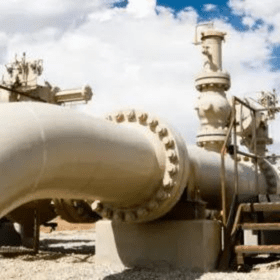Distributed Acoustic Sensing (DAS) uses fiber optic cables to provide distributed strain sensing. It is based on the Rayleigh scattering principle, which dictates that for light frequencies below the resonance frequency of the scattering medium, the amount of scattering is inversely proportional to the fourth power of the wavelength. For example, the blue color is scattered much more than the red color. Distributed acoustic sensors (DAS) can monitor mechanical vibrations along thousands of independent locations using optical fiber. According to the Consegic Business Intelligence report, the Acoustic Wave Sensor Market size is estimated to reach over USD 2,003.69 Million by 2030 from a value of USD 872.98 Million in 2022, growing at a CAGR of 11.2% from 2023 to 2030.
Working principle of DAS
DAS is a technology that uses fiber optic cables to detect acoustic signals in real time over long distances and even in harsh environments. The system works by sending thousands of short laser pulses down the fiber optic cable every second. A small portion of the light is reflected by the fiber. This process of reflecting the light is called the Rayleigh backscatter. Vibrations from the surrounding environment can disturb the backscatter, which the DAS interrogator detects. The interrogator measures the scattered light, recording a “fingerprint” of the fiber. This process is repeated. The time it takes for the laser pulse to travel back to the fiber allows the backscatter event to be mapped to a specific distance along the fiber. Algorithms in the interrogator recognize the unique signature of each type of event, and any events of concern are reported. This principle can be used in various conditions, including pipeline monitoring, rail monitoring, subsea monitoring, and more.
Role of DAS in Pipeline Monitoring
DAS technology plays a crucial role in maintaining the safety of pipelines that transport essential resources like oil, gas, water, and other chemicals. The technology offers continuous, real-time surveillance of pipelines. It enables operators to detect and respond to anomalies quickly, thus preventing potential hazards and ensuring a smooth, safe operation of pipeline systems.
Detection of Leaks and Ruptures
Leak and rupture detection is one of the main uses of DAS in pipeline monitoring. DAS can detect even the smallest alterations in sound waves that point to the existence of a leak. Due to its extreme sensitivity, the technique can find even small leaks that conventional approaches can miss. For example, when a leak happens, the leaking fluid produces distinct acoustic characteristics that DAS can detect. Early detection is essential for large-scale clean-ups to have as little of an impact on the environment and to cost less.
Third-party Interference and Unauthorized Activities
Pipelines are frequently susceptible to unauthorized activity, including digging and tampering, and third-party influence. By picking up on the vibrations and audio signals relating to these kinds of activities, DAS can keep an eye out for these outside risks. The technology can promptly notify pipeline operators of possible interference so that immediate action can be taken. This feature is very helpful in reducing mishaps brought on by unintentional harm during construction projects or intentional sabotage.
Structural Health Monitoring
Beyond finding leaks and outside threats, DAS is useful for keeping an eye on the structural strength of pipelines. It is capable of identifying structural problems, corrosion, and other alterations in the pipeline’s integrity. DAS extends the life of the infrastructure by giving operators proactive maintenance and repairs by giving constant data on the state of the pipeline. Early structural problem diagnosis can save expensive repairs and catastrophic breakdowns that could have serious negative effects on the environment and the economy.
Environmental Impact and Safety
DAS technology makes a major contribution to both safety and environmental preservation. Oil spills and other environmental catastrophes caused by pipeline failures are less likely to occur when DAS offers continuous and real-time monitoring. Quick identification of leaks and other problems enables prompt action, reducing environmental harm and improving general safety. Additionally, DAS supports sustainable pipeline operations by guaranteeing adherence to environmental standards and regulations.
Integration with Other Monitoring Systems
DAS can be linked with other monitoring systems, such as Unmanned Aerial Vehicles (UAVs) and Supervisory Control and Data Acquisition (SCADA) systems, to improve monitoring effectiveness. When DAS is combined with these technologies, a multi-layered surveillance network with various monitoring and data collection levels is created. To ensure a smooth operation, addressing these difficulties calls for sophisticated data analytics and strong integration frameworks.
Cost-effectiveness and Economic Benefits
Since DAS can avert expensive mishaps and lower maintenance costs, it is ultimately more cost-effective than initially. DAS provides ongoing monitoring, guaranteeing the early detection of possible issues that traditional periodic inspections may miss. Implementing DAS has financial advantages such as decreased repair costs, less downtime, and improved operational effectiveness. Given the high return on investment, pipeline operators can afford to choose DAS.
Challenges and Limitations
Similar to every other technical implementation, DAS has its difficulties. Issues might arise from technical and operational issues, such as the requirement for exact calibration and data interpretation. False positives can also result in needless reactions and higher operating expenses when non-threatening behaviors trigger alarms. To overcome these obstacles and raise the precision and dependability of DAS systems, ongoing research and technological developments are being made.
Future Trends and Innovations
DAS technology appears to have a bright future in pipeline monitoring since new developments are anticipated to further expand its capabilities. Using machine learning and artificial intelligence together to enhance data analysis and predictive maintenance is one of the emerging trends. Faster reaction times and even more accurate monitoring will be possible thanks to these developments. Moreover, DAS’s prospective uses go beyond pipeline monitoring to include other vital infrastructure domains like electricity grids and railroads, hence expanding its influence.
Conclusion
Pipeline monitoring is being revolutionized by Distributed Acoustic Sensing (DAS) technology, which allows continuous, real-time surveillance that improves safety, lessens the environmental impact, and has substantial financial advantages. Notwithstanding obstacles, DAS appears to have a promising future since new developments are expected to increase its efficacy and expand its range of uses. Eventually, DAS will become more and more important in guaranteeing the integrity and safety of critical infrastructure as technology advances.









